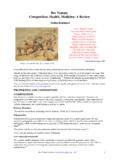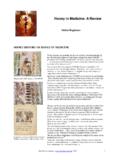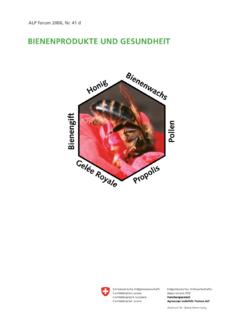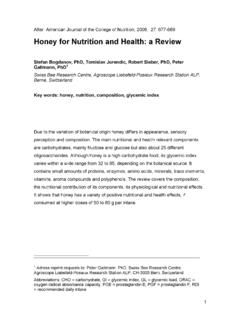Transcription of Honey Authenticity: a Review
1 Swiss Bee Research Centre (2002)page 1 of 22 Honey authenticity : a Review Stefan Bogdanov1 and Peter Martin21 Swiss Bee Research Centre, Dairy Research Station, Liebefeld2Q. P. Services, Hayes, Great Britainafter: Bogdanov S., Martin P., (2002) Honey authenticity , Mitteilungen aus dem Gebiete der Lebensmitteluntersuchung und Hygiene 93, is one of the very few natural foods which is offered today. The composition and the main quality criteria for Honey are summarised in the Swiss Food Manual (1) and also in different monographs (2, 3).The Codex Alimentarius Standard and the EU Council DirectiveThe Honey standards of the Codex Alimentarius (CA) (4) and of the European Community (5) have been revised recently.
2 The changes in the standards and the analytical methods used for their determination, following the advice of the International Honey Commission, were recently reviewed (6). The standards of the Codex Alimentarius and the EU are very similar. The Codex Alimentarius Honey standard is more detailed, containing references to quality factors such as heavy metals, pesticides and definition of Honey in both standards is the same: Honey is the natural sweet substance, produced by Honey bees from the nectar of plants or from secretions of living parts of plants or excretions of plant-sucking insects on the living parts of plants, which the bees collect, transform by combining with specific substances of their own, deposit, dehydrate, store and leave in honeycombs to ripen and mature.
3 According to the CA standard the essential composition and quality factors are: Honey sold as such shall not have added to it any food ingredient, including food additives, nor shall any other additions be made other than Honey . Honey shall not have any objectionable matter, flavour, aroma, or taint absorbed from foreign matter during its processing and storage. The Honey shall not have begun to ferment or effervesce. No pollen or constituent particular to Honey may be removed except where this is unavoidable in the removal of foreign inorganic or organic Honey shall not be heated or processed to such an extent that its essential composition is changed and/or its quality impaired In the EU council directive, Annex II the same essential composition and quality factors are mentioned, but the text is formulated differently.
4 Thus according to both standards Honey should be new Honey compositional criteria of both standards are summarised in table 1. The meaning of these standards has been discussed recently (6). Compared to the previous standards there are some changes:xThe new maximum limit for the water content is fixed at 20 %, while the old standards (and also that of the Swiss Food Directive) were at 21 %.Swiss Bee Research Centre (2002)page 2 of 22xThere is a change in the HMF and Diastase limits:the limits of maximum 40 mg/kg HMF and minimum 8 diastase units are valid after processing and blending, while the old CA standards had limits of 80 mg/kg and 3 diastase some circumstances both standards will allow the fine filtration of Honey , removing all the pollen, as long as the Honey is described as filtered.
5 In the present standards the humidity limit is lowered to 20 %, which is the same as in the previous Swiss Food Directive. Indeed in the present directive it had to be harmonised with the old European limit of 21 %. In both standards it is remarked that the HMF and the diastase limits are valid after processing and blending of Honey . This can be interpreted to mean that these two quality factors are not valid during the whole shelf life of Honey . Indeed, it has been a concern of the Honey trade for a long time, mostly in non European countries, that these two quality factors are often not fulfilled in retail Honey during the shelf life of the Honey , especially during storage at higher temperatures.
6 The removal of pollen will make the determination of botanical and geographical origin of Honey much more difficult, if not impossible unless the law in each member state permits inspectors to enter packing plants to take raw material samples and insists that packers keep full records proving compositional criteria for Honey of both standards are very similar. However there are also some differences: xThe Codex Alimentarius standard refers only to retail Honey and there is no special mention of baker s and industrial Honey . This is planned to be added in a future addendum to the standard.
7 XIn the EU Directive the quality criteria hydroxymethylfurfural (HMF) content, diastase activity and Honey acidity are intended for application by commercial partners and governments, while according to the CA standard they are only for voluntary application between trade partners. xAccording to the EU Directive Honey is referred to as a product of Apis mellifera, the European Honey bee, while the Codex Alimentarius Honey is defined as a product of all Honey bees. The Honey definition of the Codex Alimentarius is more correct, as different honeys are offered on the world market, with a predominance of course of Apis mellifera Honey .
8 Indeed, a major part of Asian Honey is produced by the Asian bee, Apis cerana. The Honey , produced by that bee has a composition similar to that of the Apis mellifera Honey , but has a higher water content and no special compositional criteria have been methods used for the determination of the quality factors are described only in CA standards, while the EU Directive refers to the Codex methods without naming them explicitly, as is to be expected under the principle of Swiss Food Legislation will have to adapt to the new Honey Codex Alimentarius standard and the EU Honey directive.
9 From a methodological point of view no adaptations are necessary for the Swiss Food Manual, as the same methods, which are used for the new quality factors according to the Codex Alimentarius, are already part of the present Swiss Food Manual. On the other hand, the Swiss Food Directive has to be harmonised with the new CA standard and the EU directive. authenticity issues A major concern of food control is to ensure that Honey is authentic in respect of the legislative authenticity of Honey has two different aspects:Swiss Bee Research Centre (2002)page 3 of 22xAuthenticity in respect of Honey productionxAuthenticity in respect of descriptions: geographical and botanical origin, natural , organic , raw and unheated honeyIn determining Honey authenticity both aspects should be considered.
10 There are several reviews on different Honey authenticity issues (7-10). The objective of this Review is to examine all authenticity issues and the methods used to prove authenticity . In order to make the Review more readable and compact, an attempt is made to concentrate on the most important issues, without giving too much detail. Researchers looking for greater details on methods and issues are advised to consult the cited of productionProcessing by the beekeepers and the industryRetail Honey has always been subjected to some form of processing during Honey production.











